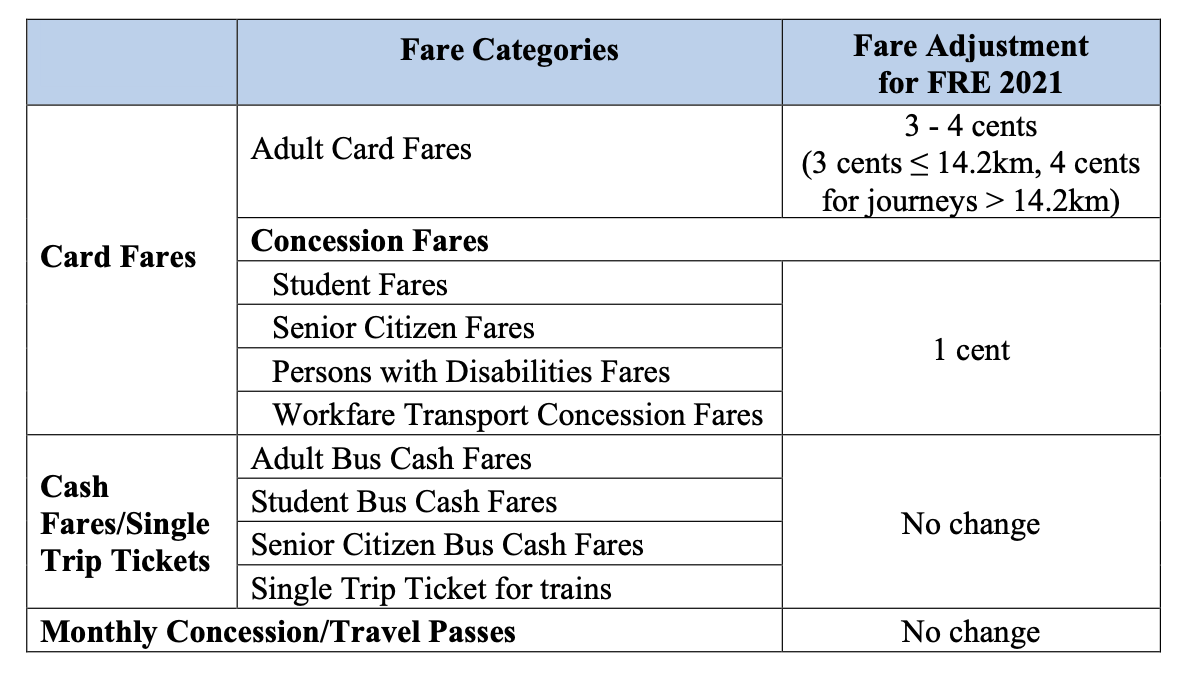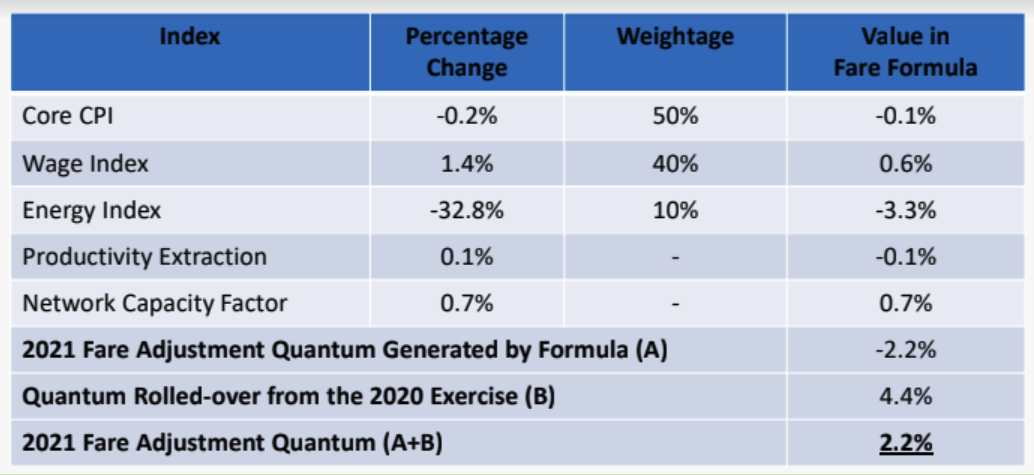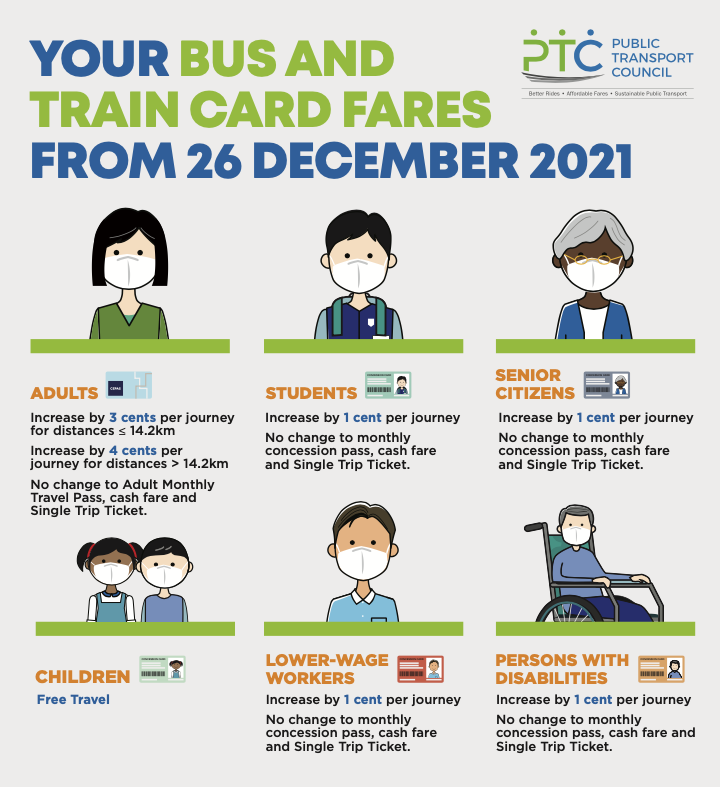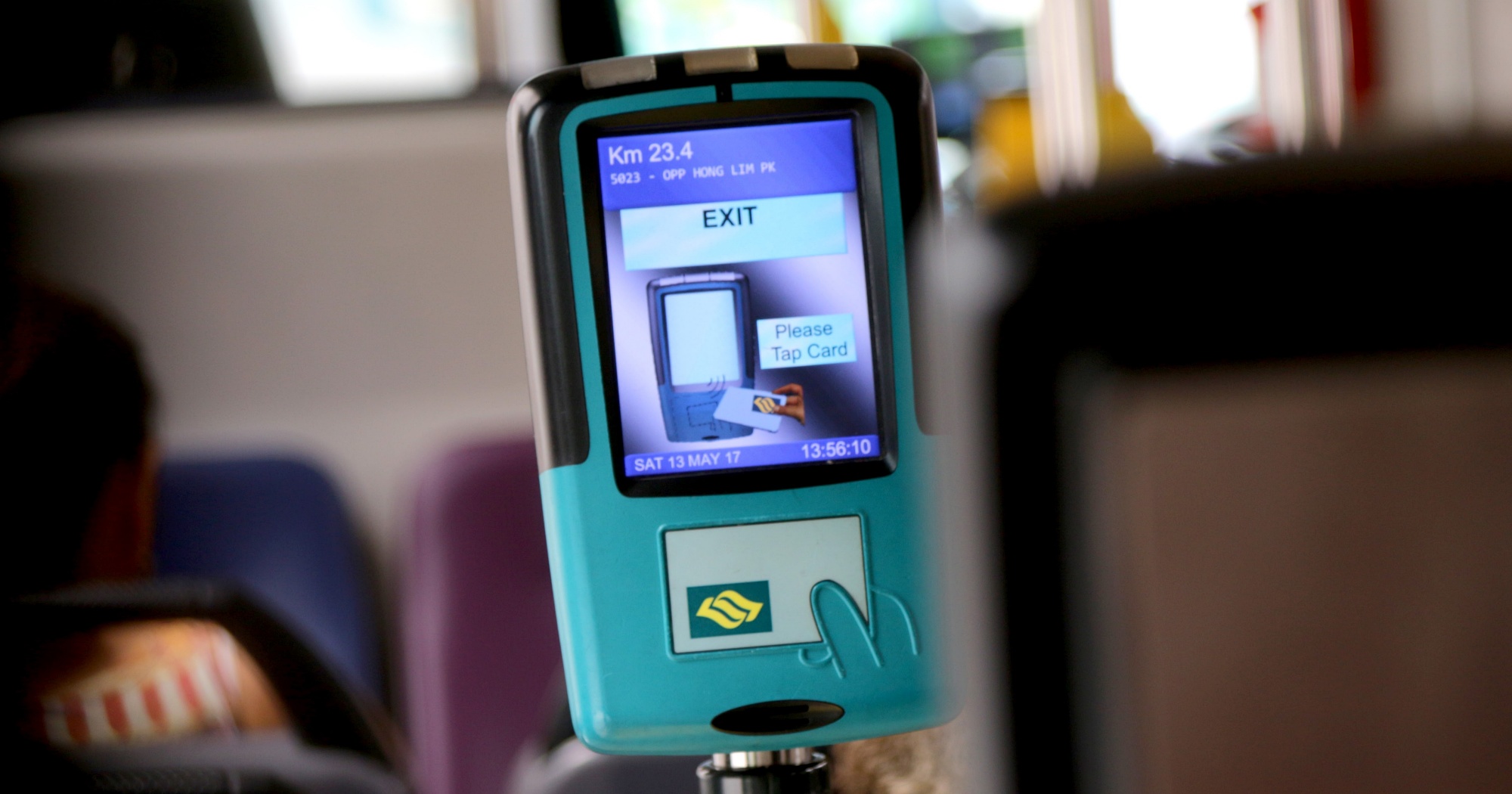Follow us on Telegram for the latest updates: https://t.me/mothershipsg
The Public Transport Council has completed its Fare Review Exercise for the year and announced that it will cap this year's public transport fare increase at 2.2 per cent.
This works out to a fare increase of 3 to 4 cents for adult card fares, and 1 cent for concession fares.
Prices of single trip tickets for train and bus cash fares will remain unchanged.
Prices of monthly concession passes and travel passes will also remain unchanged.
Here are the increases for each fare category:
 Courtesy of PTC.
Courtesy of PTC.
How did the PTC arrive at an increase of 2.2 per cent?
As with all fare adjustments -- both the increases and the decreases -- over the years, this year's fare increase quantum was calculated using a formula, albeit one that was tweaked slightly to account for the effect of Covid-19 on public transport ridership.
Just to recap, here's the fare increase formula:
In 2020, the Covid-19 pandemic, as well as the restrictions, caused a drastic drop in public transport ridership.
At the same time, public transport operators were operating largely at pre-Covid-19 frequencies and also kept to pre-Covid-19 operating hours.
In short, there was more supply than demand.
And that brings us to the Network Capacity Factor.
This component was originally incorporated into the formula to account for the costs incurred when there's more supply resulting from enhancements to public transport capacity — for instance, the initial stages of opening new MRT lines or injecting more buses or trains into the public transport system that are in excess of passenger demand.
The PTC said the Network Capacity Factor was "not designed to track short-term fluctuations in public transport demand and supply during exceptional periods".
And so if the council had used ridership figures from the whole of 2020, it would have resulted in a Network Capacity Factor of 50 per cent, which is much higher than the Network Capacity Factors in 2019 (3.9 per cent) and 2018 (1.6 per cent).
The PTC said that a 50 per cent Network Capacity Factor — if fully factored into the formula — would translate to a fare increase of about 60 cents.
Given the exceptional circumstance, the PTC decided to take only ridership figures from January 2020, before ridership was affected.
This resulted in a Network Capacity Factor value of 0.7 per cent, instead of 50 per cent.
If you are interested in the other indexes and their values in the formula, you can check out this table below.

The formula produced a fare adjustment quantum of -2.2 per cent (which typically means a drop in fares). However, last year's fare increase of 4.4 per cent was rolled over to this year. So the total fare adjustment quantum is:
-2.2 per cent + 4.4 per cent = 2.2 per cent
How much more revenue will this fare increase result in?
The PTC said a fare adjustment of 2.2 per cent translates to an increase in fare revenue of about S$34.2 million a year.
"The increase in annual revenue for SBS Transit Rail and SMRT Trains is S$4.6 million and S$10.0 million respectively. Fare revenues for bus and Thomson-East Cost Line (TEL) collected by LTA will increase by S$19.6 million."
Increases in revenue will go towards reducing operating subsidies, which currently stand at about S$2 billion annually across bus and rail services, said the council.
Times are tough, why is the PTC allowing a fare increase?
According to the PTC, this increase will help mitigate — but not cover — the costs of running public transport services.
The council added that public transport operators have been facing rising cost pressures, like soaring energy prices.
Aside from that, signs like the recovery of the economy and the labour market went into the council's decision to grant the full 2.2 per cent fare increase.
Operators SBS Transit and SMRT have applied for the full adjustment of 2.2 per cent, citing higher costs needed to maintain reliability and safety, as well as an intensified cleaning regime.
SBS Transit's train segment reported a loss of "tens of millions of dollars" in its latest financial year, even with government support.
SMRT Trains, on the other hand, managed to turn a profit of S$23 million, but only with Covid-19 support from the government.
According to the PTC, one of these two operators incurs about S$4 million a year to implement an intensified cleaning regime and safe management measures.
Richard Magnus, chairman of the PTC, also said the council has to balance commuters' interests with the need to ensure a financially sustainable public transport system.
"This means that bus and train fares would need to be adjusted from time to time. We seek commuters’ understanding that it is not possible to keep deferring fare increases as they are needed to support the rising operating costs, such as energy and wages, for our public transport system."
What kind of help is available for commuters who are affected by the fare increase?
Magnus pointed out that beyond freezing fares last year, the council has continued to protect the concessionary groups and provide support for needy commuters.
The government will be tapping on the Public Transport Fund to provide 600,000 Public Transport Vouchers valued at S$30 each.
According to the PTC, this is the largest number of Public Transport Vouchers ever set aside, with the broadest household coverage.
In addition, SBS Transit and SMRT Trains will contribute 5 per cent and 20 per cent of their expected increase in fare revenue to the Public Transport Fund respectively.
This means that SBS Transit will contribute S$0.23 million, while SMRT Trains will contribute S$2 million.
The new fares will take effect on December 26.

Top image by Joshua Lee.
If you like what you read, follow us on Facebook, Instagram, Twitter and Telegram to get the latest updates.
